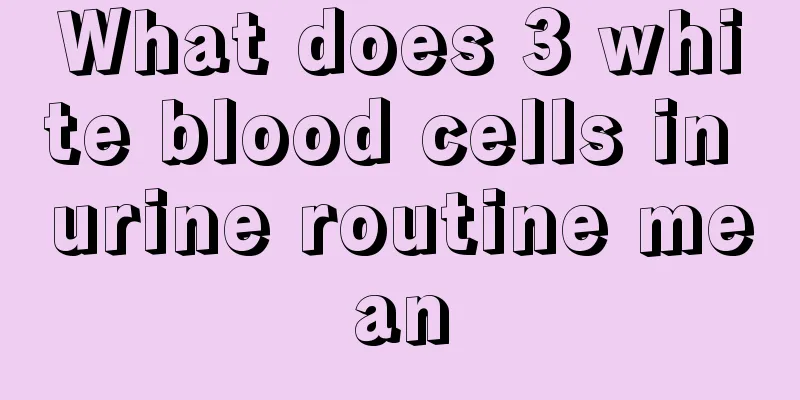What's up with the direction of blood circulation

|
Blood exists in many animals or human bodies, and the role of blood is very important. It is essential to transport nutrients and increase pressure to promote circulation. Blood can be seen in many places in our normal life, for example in hospitals or when you accidentally scratch yourself and bleed, you can see red blood. Let’s take a brief look at the direction of blood circulation. 1. Blood circulation is divided into systemic circulation and pulmonary circulation. Pulmonary circulation: right ventricle--pulmonary artery--capillary network in the lungs--pulmonary veins--left atrium Systemic circulation: left ventricle--aorta--capillary network throughout the body---superior and inferior vena cava--right atrium Blood circulation route: left ventricle→(arterial blood at this time)→aorta→arteries at all levels→capillaries (material exchange)→(become venous blood after material exchange)→veins at all levels→superior and inferior vena cava→right atrium→right ventricle→pulmonary artery→pulmonary capillaries (material exchange)→(become arterial blood after material exchange)→pulmonary veins→left atrium→finally return to the left ventricle and start a new round of circulation. Among them, the blood circulation from the left ventricle to the right atrium is called blood systemic circulation, and the blood circulation from the right ventricle to the left atrium is called blood pulmonary circulation. 2. Blood circulation begins in the left ventricle. After the blood is pumped out from the left ventricle, it flows through the aorta and several arterial branches derived from it, delivering the blood to the corresponding organs. The arteries branch out multiple times, their diameter gradually becomes thinner, and the number of blood vessels gradually increases, eventually reaching the capillaries, where they exchange substances with tissue cells through the intercellular fluid. The oxygen and nutrients in the blood are absorbed by the tissues, while the carbon dioxide and other metabolic products in the tissues enter the blood, turning arterial blood into venous blood. During this period, the diameter of the veins gradually becomes thicker and the number gradually decreases until finally all the veins converge into the superior vena cava and the inferior vena cava. The blood then returns to the right atrium, and from the right atrium to the right ventricle, thus completing the systemic circulation process. 3. The blood circulating in the human body can transport nutrients to all parts of the body, collect waste in the human body and excrete it out of the body. When blood flows out of the heart, it transports nutrients and oxygen to all parts of the body; when blood flows back to the heart, it transports carbon dioxide and other wastes produced by the body to the excretory organs and excretes them out of the body. The total blood volume of a normal adult is approximately 8% of body weight. Blood transports oxygen, food, nutrients and hormones throughout the body and carries metabolic waste products to the excretory organs. Blood can also protect the body by producing special proteins called "antibodies". Antibodies can stick to microorganisms and prevent their activity. Other cells in the blood then surround, engulf, and destroy these microorganisms. Blood can also coagulate into clots to help us stop bleeding wounds, prevent large amounts of blood loss and microbial invasion. The above is a relatively simple answer to the question about the direction of blood circulation. I hope that through such a detailed description, many people can understand the relevant information. We need to keep ourselves in good health so that we can challenge new things every day. Don't smoke, drink, or eat spicy food. It is also important to exercise moderately. |
<<: How to use the meridian tapping stick
>>: What does a blood test check?
Recommend
Can vascular interventional treatment of liver cancer prolong the patient's life? It can achieve the effect of prolonging life
Vascular interventional treatment can prolong the...
Diet for weight control in late pregnancy
The most obvious phenomenon during pregnancy is w...
What should I pay attention to in my diet after endometrial cancer surgery
What dietary precautions should be taken after en...
What causes itching under the testicles?
In summer, it is easy for the skin to become sens...
What is the cause of urinary tract infection after kidney transplantation?
Kidney transplantation is a method of kidney tran...
What should I do if the breast cancer tumor does not shrink after four chemotherapy sessions?
What should I do if the breast cancer tumor does ...
Cell preservation solution
We all know that cervical cancer is a fatal gynec...
Is the recurrence rate of lymphoma high after 5 years?
Is the recurrence rate of lymphoma high after 5 y...
How long can a person with a large area of cerebral infarction live
Cerebral infarction, also known as cerebral infar...
How to train clavicle muscles
The clavicle is close to the shoulder joint and c...
How to deal with waste sulfuric acid
In daily life, especially in chemical production,...
What is the probability of thyroid cancer being excluded
The possibility of thyroid cancer to be excluded ...
Coleus is harmful to humans
Coleus is a relatively common ornamental plant wi...
What should I do if my shoes get stuck?
In the past, people would go to shoe stores in pe...
What is the reason for feeling sleepy after lunch
Many friends feel sleepy after lunch. They can’t ...









